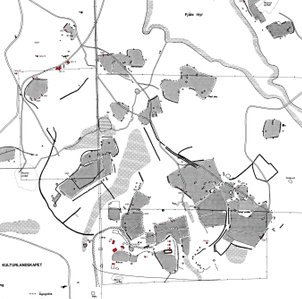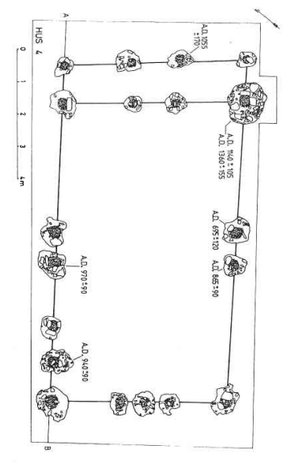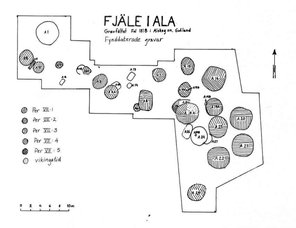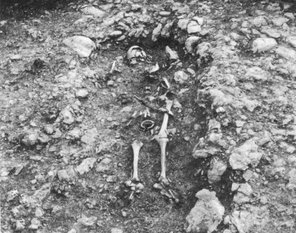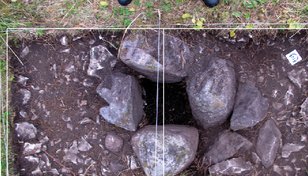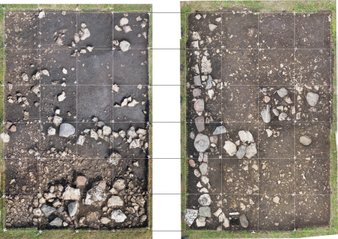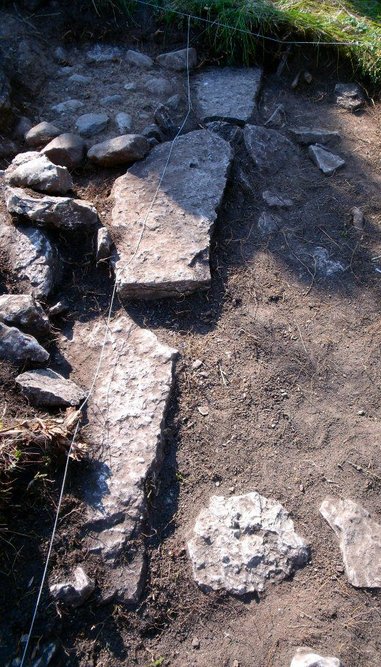GOTLAND ARCHAEOLOGICAL
FIELD SCHOOL
FJÄLE, A DESERTED FARMSTEAD
"Rudera efter Fjälebysens hus"
"Stone traces from the Fjälebysens house"
Taxation map, 1700
On the northwest border of the parish Ala in Gotland lays an intact farmstead, untouched by modern agriculture. The landscape today is mostly woodlands with some moors. When looking back in history, through the historical maps, the site has never been cultivated. On the earliest map, however, from the 18th century there are some pastures and a note from the land surveyor. The note is written besides some stone impediments and says "Stone traces from the Fjälebysens house".
Who is Fjälebysen? There is a legend from the parish that says that the farmer at Fjäle was very rich and a big man in the community. Since he lived in the outskirts of the parish he insisted that the priest would wait every Sunday and not start the mass without him. Now, the Fjäle farmer was a pretty ignorant man and didn't trouble himself with being on time.
The priest waited every sunday for the farmer to show up, until one day when he had had enough. The farmer was particulary late this day and the priest decided to start the mass without him. When the farmer eventually came he was so enraged that he rushed up to the chancel and killed him on the spot. The other farmers in the parish had by this time also had enough and killed the Fjäle farmer in return. This led to the belief that the site was a little bit haunted and apperently abandoned. Until the archaeologists showed up.
The site was rediscovered by Dan Carlsson during work with his doctoral thesis in the 1980's. In 1984 he surveyed the area and found a farmstead, complete with houses, gravfields, fields, pastures, roads and wells. The farm has a continuity that stretches from the year 200 AD to the 1360´s. That is more then 1000 years.
He also conducted several excavations in the 80's over the Fälebysens house, some of the fields, two wells and a large part of the Iron Age grave field that is connected to the farm. Through this work he found out how the farm had developed and been destroyed. To the right you can se the original surveying of the farmstead and its agricultural lands.
THE HOUSE REMAINS
There are more than 13 house remains in the settlement area at Fjäle. There are two noticable house remains dating from around 200 AD. These are kalled kämpgravar (giant graves) on Gotland due to the large stone walls that supported the house foundation. There are around 6-7 house remains from the Vendel and Viking period, 5 of which have been excavated. And last but not least, there are 4 house remains from the Medieval Period.
During the investigations in the 80's, 6 of the house remains were fully or partly excavated. The excavation of the earliest house determined that Fjäle had been established as a farm in 200 AD and that the first house remains were used up to the 6th century. Between this date and up to the desertion of the farm in the Medieval period, there are 5 houses that date from the Vendel and Viking period. These datings have been gained by using the C14 method on the posts from the houses.
The last house on the site, the Fjälebysens house, was fully excavated and it appears to have burned down. There were alot of coin finds amoung the find material and the last coin was minted in 1360. There was alot of turmoil on Gotland in the middle of the 14th century, both the plauge and a Danish invasion ravaged the island. The answer to the desertion of Fjäle may llie in one, or both, of these causes. It may be a more plausible answer than the murder of a priest and the retaliation from the parish folk.
THE PEOPLE
One of the three grave fields connected to the farm has been excavated. The graves date mainly from the period 550-750 AD, the Vendel period, with some Viking age graves. The three different gravefields may indicate different linages of the people who inhabited the farm, or a difference in bruial practice or the view of the old graves, or it may just signify that the old gravefield was too "full" and an expansion was made.
The graves also show a social stratification. Some individuals are buried with a lot of grave goods including swords, combs, brooches, pots, beads and more, while some are layed to rest without anything. There are also graves that are only covered with one layer of stone and are placed in the border of a bigger grave. This leads to the questions of thralls in the Iron Age and maybe these people followed the farmers family or were placed there upon their death.
No traces of the graves from the earliest period of settlement in Fjäle have been found; graves from this period in Gotland normally don't leave any signs above the ground and are therefore often less represented in investigations. After the Vendel and Viking period the farmer's family was, of course, buried in the parish church.
One of the three gravefields.
A late Viking Age burial of a man with a ring brooch and a one sided sword.
GOTLAND ARCHAEOLOGICAL FIELD SCHOOL
The aim for the return to Fjäle, since Dan Carlsson's investigations in the 80's had not been further researched, was to investigate more of the houses to define the time-line of settlement, the purpouse of different houses and the economical and social apsects of the farm further. The investigation took place during 2012 and with the help of our students we excavated parts of 4 houses from the Vendel to the Medieval period. The excavation resulted in the discovery of a workshop from the Viking/Medieval period, the precursor to the Fjälebysens house, a Vendel period house with surprisingly large postholes and no finds or cultural layer in it and more out-house like barns.
The precursor for the Fjälebysens house was found some 50 meters from the last farm house. In the terrain it looked like a pile and was very over grown with trees. The pile turned out to be the destroyed hearth of the house. The stone foundation was torn up and there were not alot of finds amoung the stone packing that covered the inner part.
The people had probably reused the good stones when they erected their new farmhouse and therefore also cleaned out the house before moving. The house was a direct copy of the Fjälebysens house and the two structures most likely follwed eachother.
We now had a more clear vision of the life of the farm with the source material archaeological data, finds and datings. Fjäle is a large contribution to the understanding and development of an Gotlandic farmstead and represents a large amount of arhcaeological research.
All the material from the farmstead is not yet fully analyzed and this was just a small summary of the site, the ancient remains and the archaeological research that has been undertaken.
Read more about Fjäle and the Gotlandic farm by expanding the document on the left.
The probable Vendel period house (the post holes had no remains of wood that could be carbon dated) was a small house, single aisled, and consisted of just 6 posts. The postholes were noticable before excavations due to the size of the supporting stones and the small dip that was formed by the hole.
A trench that covered the inside of the house yielded no finds and the house had probably been cleaned out before abandonment. The purpose of the house is still unclear.
The workshop that was found was built on a small stone foundation, traces of earlier buildings were also found as postholes. The entire inside cultural layer of the house was covered in charcoal and it probably worked as some sort of smithy.
Outside of the house, in a trash pile of heat affected stones, we found a mould. The mould was for a belt decoration which had been found earlier at Fjäle. This house had no earlier counterparts at Fjäle and showed that metalworking took place directly at the farmsite.
